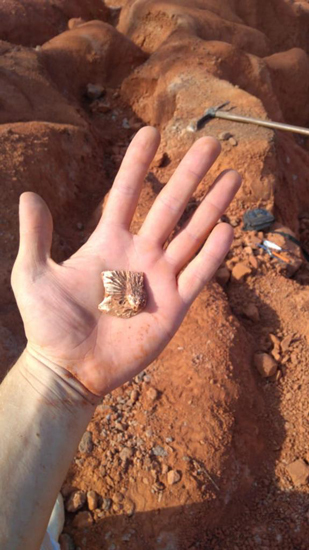Adding to the Ornithosuchidae – Dynamosuchus collisensis
Dynamosuchus collisensis – Late Triassic Bone Crushing Scavenger
A new species of ancient reptile, a distant relative of modern crocodilians has been named and described. The two-metre-long, terrestrial predator has been named Dynamosuchus collisensis and it is the first member of the Ornithosuchidae family of archosaurs to have been discovered in Brazil. The fossilised remains of the fearsome Dynamosuchus were found in March 2019 in the municipality of Agudo, Rio Grande do Sol in southern Brazil. This is only the fourth ornithosuchid to have been described, the first was found in Scotland (Ornithosuchus) and described in 1894, whilst the other two genera (Riojasuchus and Venaticosuchus), were named and described in 1969 and 1971 respectively, from fossil discoveries made in Argentina.
Dynamosuchus collisensis is the first ornithosuchid to have been found for nearly five decades.
A Life Reconstruction of the Fearsome Dynamosuchus collisensis
Picture credit: Márcio L. Castro
Dynamosuchus collisensis
Writing in the academic journal Acta Palaeontologica Polonica, the researchers from the Universidade Federal de Santa Maria (Brazil), Museo de la Plata (Argentina) and Virginia Tech (USA), estimate that Dynamosuchus roamed Gondwana around 230 million years ago (Carnian faunal stage of the Triassic) and that it may have been a scavenger.
Members of the Ornithosuchidae are characterised by the shape of their snout. The premaxilla tends to project forward and they have two pairs substantial, conical teeth located in the anterior portion of the lower jaw (dentary). Like modern crocodilians these animals were covered in bony armour (osteoderms), but unlike today’s crocodiles, caiman and alligators, they were much more at home on the land than in water.
Like other ornithosuchids, Dynamosuchus probably spent most of its time on all fours, but it may have been capable of adopting a bipedal stance, perhaps when a turn of speed was required to escape from other bipedal predators such as the recently described herrerasaurid Gnathovorax (G.cabreirai).
To read about Gnathovorax: Superb Fossil Sheds Light on Triassic Terrors.
One of the Osteoderms (Bony Scales) Found at the Fossil Quarry
Picture credit: Rodrigo Temp Müller (Universidade Federal de Santa Maria)
A Specialised Scavenger
Studies of the skulls of these archosaurs indicate that they had strong jaws, but a relatively slow bite speed and the projecting premaxilla was not well suited to handling struggling prey. As a result, it is has been speculated that ornithosuchids were specialised scavengers, using their powerful jaws and their curved, serrated teeth in the upper jaw to consume carcasses. The genus name is from the Latin meaning “powerful crocodile”, whereas the trivial name is a Latinised form of “morro” a reference to the fossil quarry located at the base of the “Morro Agudo”.
A Close-up View of the Head of Dynamosuchus collisensis
Picture credit: Márcio L. Castro
The Santa Maria Formation
The fossil material from the Santa Maria Formation adds to the number of fossil vertebrates known from the Late Triassic of Brazil. The terrestrial ecosystem was complex with synapsids, rauischians, rhynchosaurs, aetosaurs and numerous dinosauromorphs as well as some of the earliest types of dinosaur known. Dynamosuchus collisensis represents the first reptile with specialised anatomical adaptations for scavenging (necrophagy), to be discovered in a single fossiliferous site along with fossil remains of dinosaurs. The new ornithosuchid further demonstrates a link between the animals associated with the Argentinean and Brazilian basins during the Carnian stage of the Triassic.
Everything Dinosaur acknowledges the assistance of a media release from the Universidade Federal de Santa Maria in the compilation of this article.
The scientific paper: “The first ornithosuchid from Brazil and its macroevolutionary and phylogenetic implications for Late Triassic faunas in Gondwana” by Rodrigo T. Müller, M. Belén Von Baczko, Julia B. Desojo, and Sterling J. Nesbitt published in Acta Palaeontologica Polonica.
Visit the Everything Dinosaur website: Everything Dinosaur.




